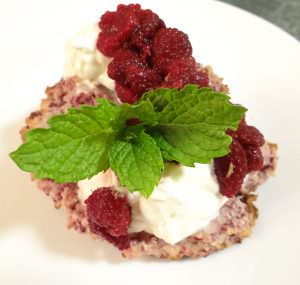


currently unavailable This California seed selection found in the Sierra mountains combines both the true thimbleberry and its close cousin Purple Flowering Raspberry. The flowers tend to have pink hues and are sometimes white with pink spots. It ripens its fruits 2-4 weeks earlier than our Pink Thimbleberry. Of course the flavor is out of this world in the raspberry department. Thimbleberry is a great raspberry but cultivation of it is filled with interesting side trips in horticulture as well as human culture. The plants themselves are easy to grow and this strain is no exception. But harvesting the slowly ripening clusters over a long period is very time consuming. The low yields per plant makes it like no other raspberry and requires someone who is cultivating it patience and understanding.
I have tried numerous Michigan forms of the thimbleberry in southern Michigan. Certainly they grow here but the fruit is essentially non-existent no matter what I did. This California strain is by far fruitful and worth growing from the standpoint of fruiting within a cultivated setting. It just is too warm and south here for the Michigan forms of thimbleberry to fruit. California dreaming of thimbleberries.
The dark red fruit of this strain and its rich flavor is worth testing further to find higher yielding plants as well as hybrids within it to bring into fruition. The quality of the fruit is very good as it breaks apart into pieces during harvest. I know of a few hybridizers working with raspberries that are actively pursuing hybridizing this plant. Apparently the natural hybrids have been found of it in the wild, but they have not been recently located and may not exist anymore. I am not sure if that would actually improve thimbleberry to be honest. Kind of good on its own.
To germinate the seeds: Seeds are best fall planted direct in the soil. The abrasive action of the soil plus the bacterial action will help with the germination of the seed. Lightly cover the seed. Use just enough soil and screened mulch to cover the seed and hold it in place. Tamp firmly. For the indoor method store the seed in moist Canadian peat moss for 120 days at 33F-38F. Then layout in an irrigated shady area or a flat of soil mix. Germination will occur slowly with the greatest number of seedlings emerging in the second year. Regular watering is ideal. Comes up in great profusion once established.
| Plant Specs |
| Genus & Species |
Rubus parviflorus |
| Seed Source |
Michigan, originally California Sierras |
| Hardiness |
-20F or more |
| Height (ft) |
5 |
| Width (ft) |
3-5 |
| Pollination Requirements |
Best to have a small colony but probably entirely self fertile. |
| Soil |
Likes acidic rocky soil with high mineral content. Appears adaptable to variations of ph. |
| Climate |
A cool season plant-Zone 3-zone 7. |
| Ease of Cultivation |
You can grow it in light shade or sun but make sure to irrigate to keep the fruit from dropping if it becomes a dry summer. Hasn't been as productive as the pink thimbleberry we offer but it likely due to where we have it planted as the flowering is still very good with this species. |

